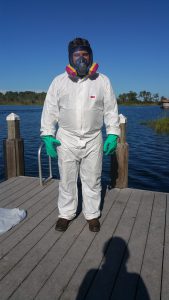 Personal protective equipment (PPE) is associated with many dangerous activities. Football players wear helmets, soccer players shin guards, construction workers have safety glasses (sounds like the start of The Village People!). Even pesticide applicators have equipment like gloves, goggles, and respirators they must wear, but does it matter? With Halloween just around the corner we have to ask, is PPE wearing a costume or putting on invincible armor?
Personal protective equipment (PPE) is associated with many dangerous activities. Football players wear helmets, soccer players shin guards, construction workers have safety glasses (sounds like the start of The Village People!). Even pesticide applicators have equipment like gloves, goggles, and respirators they must wear, but does it matter? With Halloween just around the corner we have to ask, is PPE wearing a costume or putting on invincible armor?
In the examples above we can easily see how PPE can help prevent injury or other harm. Safety goggles in construction help prevent debris from getting in the eyes. Anyone that has ever bumped their shin on a trailer hitch knows that a shin guard might prevent a lot of pain (and possible swearing). So how does PPE fit in with pesticide applicators?
The purpose of PPE in pesticide applications is to reduce the exposure of the applicator to pesticides. The Environmental Protection Agency (EPA) looks to reduce risk, primarily by defining and putting steps in place to reduce exposure. In risk mitigation it is important to understand that Risk = hazard (pesticide) + exposure. The EPA researches in depth to define the hazard posed by the pesticide and define the possible exposure points. From there they define the steps that reduce the chance of exposure.
If the goal is to avoid pesticide exposure to the applicator there are several ways to do this. The hands are the most likely to be exposed, so gloves are a fitting way to reduce exposure. Other pesticides may cause harm to the eyes, so protective eyewear can work. For fine particles like dust or fumigants, a respirator might be right. Coveralls help to reduce exposed skin and chemical resistant coveralls (Tyvek) even more so. Where can you find all this information? Those of you who have ever read our blog know this answer, you find it on THE LABEL.
How Does it Work?
So, there we have it PPE is an invincible cloak of armor and I never have to worry about anything again. Oh, that doesn’t seem right, surely there has to be more to it than that. Well discerning reader, you are correct, PPE does NOT eliminate ALL exposure and make one invincible. The use of PPE absolutely reduces exposure and helps prevent serious risk of harm, but it doesn’t eliminate it all together. To truly maximize protection you must take additional steps.
While PPE does a good job blocking exposure for the areas it covers, this implies that the PPE itself may be exposed. This is what it is designed to do BUT this now means the PPE itself could expose you to pesticide without proper care. Remember the mantra, dirty to dirty, clean to clean. This means only using possibly exposed surfaces (dirty) to touch other possible exposed surfaces and using clean to touch clean. Using dirty gloves to touch the inside of Tyvek or grab your clean clothes is not ideal. Keeping PPE rinsed and clean during applications can help and ALWAYS washing hands with soap and water after applications is essential as well.
It is also important to reduce OVERALL exposure by thinking about spray patterns and other mechanical controls. Thinking about the type of spray system, keeping it well maintained, and positioned such that if failure occurs exposure isn’t likely. Avoiding spraying during windy conditions or altering spray pattern can reduce exposure as well. Anything that reduces drift can help reduce exposure.
Does it Work?
Even with all this in place it is still possible to be exposed, I know, because I have been. During my time as an applicator, I did get exposed, without knowing it, and had a red face and blisters on my neck and chest. Scary, I know just ask my wife BUT I tell people all the time it is a perfect example of PPE working. Come on you had blisters, clearly it didn’t work, it’s just a costume, simply safety theater. Although I did have impacts, the red skin stopped around my eyes, because I was wearing goggles as required, and irritated my neck and chest, but not my lungs, because I was wearing a respirator. The blisters looked scary but were limited in scope and healed very quickly. The PPE protected the areas at risk and we made changes to how that type of treatment was done in the future, further reducing risk. So yes, PPE worked, so more than a costume, but does not eliminate every possible exposure, so we aren’t invincible.
None of the activities we undertake in life are 100% without risk. Our goal should be to reduce that risk below unacceptable levels, but accept the risk is never 0. When using pesticides PPE is one of the primary ways to reduce risk, but it is not the only way to reduce risk. Always read and follow your labels, keep PPE, equipment, and techniques properly maintained and thought through. All of this will make your PPE more than a costume and get closer to invincible armor.
by Dr. Brett Bultemeier
Source: UF/IFAS Pest Alert



